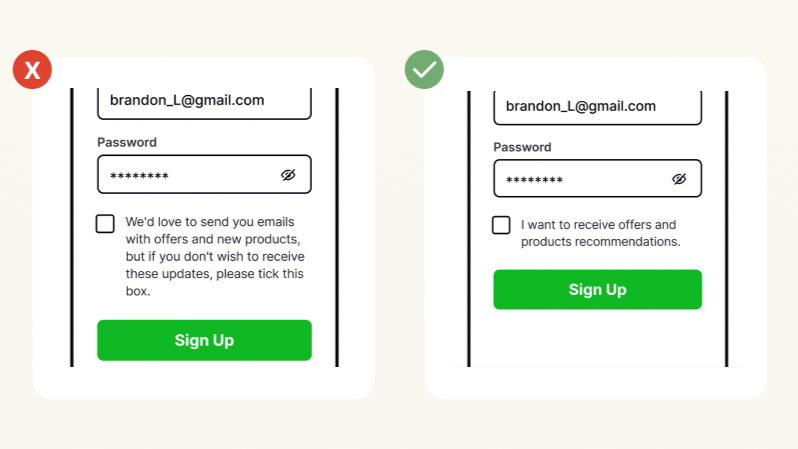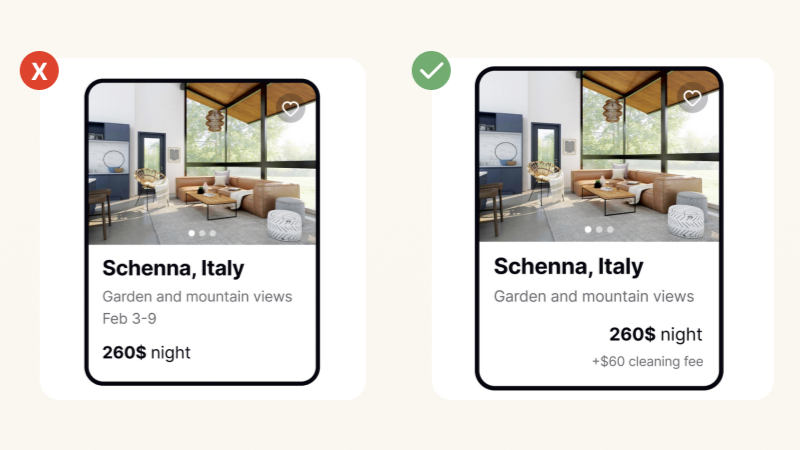The continued use of dark patterns in UX design is eroding trust across e-commerce, social media, and digital platforms. According to a 2023 Dovetail study, 56% of respondents reported losing trust in a website or platform due to manipulative design practices. But the issue doesn’t stop there – dark patterns have infiltrated a wide range of industries. A comprehensive 2024 review by the FTC, ICPEN, and GPEN examined 642 websites and apps offering subscription services worldwide. Alarmingly, 76% of these platforms used at least one dark pattern, with 67% using multiple deceptive tactics.
Defining dark patterns
Dark patterns are deceptive design tactics intentionally designed to manipulate users into taking actions that benefit companies, often at the user’s expense. These tactics can lead to unwanted purchases, collect personal information without proper consent, or trap users in unwanted agreements. The term was first coined in 2010 by UX designer Harry Brignull, and other terms such as “deceptive patterns,” “harmful design,” and “manipulative choice architecture” have also been used to describe these unethical practices.
Using psychological techniques, dark patterns push users to make choices they wouldn’t normally choose, often using System 1 thinking -quick, automatic decision making- rather than the more thoughtful System 2 thinking.
While dark patterns may provide companies with short-term benefits such as increased conversions and faster data collection, they come with significant long-term costs, including eroding customer trust, damaging brand loyalty, and exposing companies to legal and regulatory risks.
The temptation of quick gains
Businesses are often attracted to dark patterns for their short-term benefits, such as increased conversion rates, greater data collection, and higher sales. A study published in the Journal of Legal Analysis found that users exposed to dark patterns were significantly more likely to sign up for services they would normally avoid. In fact, mild dark patterns doubled the likelihood of subscription, while more aggressive tactics nearly quadrupled it.
The appeal of these quick wins is driven by the pressure to deliver immediate results. Marketing teams, product designers, and sales departments are often judged on short-term metrics such as click-through rates, sign-ups, and direct conversions. As a result, dark patterns can seem like an easy way to “tweak” the user experience for the company’s benefit, even at the expense of user trust and satisfaction.
The different types of dark patterns
- Confirmshaming
This pattern uses guilt or shame to nudge users into actions they wouldn’t otherwise take. For example, an opt-out button might be labeled, “No, I don’t care about saving money,” or “No, I’m fine with missing out on great deals.” The negative framing makes users feel bad about rejecting an offer or service, driving them toward the business’s desired action.
- Roach Motel
The “roach motel” pattern makes it easy for users to sign up for a service but incredibly difficult to cancel. Many subscription services employ this tactic, requiring users to call customer service to cancel or subjecting them to a lengthy, complex online cancellation process.
- Sneaking/Preselection
This deceptive pattern uses the default effect of cognitive bias, where options are pre-selected to push users toward decisions they didn’t intend to make. For example, additional items are automatically added to the user’s shopping cart, or a more expensive option is pre-selected.
Heuristics are the mental shortcuts we rely on that are exploited by dark patterns. Users often assume that if an option is pre-selected, it must be the “right” choice. However, these pre-selected choices may be in the company’s best interest, not the user’s.
- Fake Scarcity
This pattern exploits users’ fear of missing out (FOMO) and takes advantage of cognitive biases such as the scarcity effect, where limited availability increases perceived value. Users are rushed into making a purchase or signing up for a service under the false belief that the opportunity is limited in time.
That’s not all of them — Deceptive Patterns has compiled a comprehensive list of all types of dark patterns, offering a resource for those looking to learn more.
Persuasive vs. Deceptive Design
It’s important to distinguish between ethical, persuasive design and deceptive dark patterns. Persuasive design influences users by providing information transparently, encouraging informed choices, and respecting autonomy. In contrast, deceptive design relies on manipulating cognitive biases and undermining user autonomy, often by hiding critical information or forcing unwanted choices.
Persuasive design:
– Provides clarity and transparency
– Encourages informed choices
– Respects user autonomy
Deceptive design (dark patterns):
– Exploits cognitive biases
– Hides or misrepresents information
– Coerces users to act against their best interests
The long-term risks of dark patterns
Erosion of customer trust
One of the most damaging consequences of dark patterns is the erosion of customer trust. When users feel cheated, they lose faith in the brand, and regaining that trust becomes extremely difficult. Trust is a cornerstone of the user experience. Once compromised, it can lead to a ripple effect of dissatisfaction, bad reviews, and negative word-of-mouth. According to the Dovetail study, over 43% of respondents stopped buying from a retailer after experiencing dark patterns.
Loss of brand loyalty
Building brand loyalty is a difficult task, but losing it can happen quickly. When customers experience dark patterns, they are more likely to abandon the brand in favor of competitors that prioritize user-centric design and transparency. Dark patterns often inspire users to share their negative experiences through online reviews, spreading the damage quickly.
For example, over 40% of Dovetail respondents reported financial consequences from dark patterns, including being tricked into buying more expensive products or being rushed through confusing purchase processes. Such experiences can foster long-term resentment and make it nearly impossible to rebuild customer loyalty.
Legal consequences
Dark patterns have not only provoked consumer backlash, but have also attracted the attention of regulators around the world. As more governments recognize the harm caused by manipulative designs, laws and regulations are being introduced to address the issue.
- The General Data Protection Regulation (GDPR): Under GDPR, companies are required requires to provide clear and transparent user consent mechanisms, including easy opt-out options. Non-compliance has led to hefty fines for companies like Google and Meta, which were fined $170 million and $68 million, respectively, by French authorities for using dark patterns in their cookie consent processes.
- The Digital Services Act (DSA): The EU’s DSA, which went into full effect in February 2024, directly addresses dark patterns. The DSA prohibits online interfaces that “deceive, manipulate, or otherwise materially distort” a user’s ability to make free and informed decisions”. Non-compliance with the DSA can result in fines of up to 6% of a company’s global annual turnover.
- U.S. Federal Trade Commission FTC regulations (FTC): The FTC also monitors dark patterns, particularly in subscription services and privacy violations. The FTC recently took action against several companies for using manipulative UX practices in their subscription models, highlighting the increasing legal risks for companies using dark patterns.
To know more about some recent legal repercussions that happened in the past, Deceptive Patterns also complied a list of 100 company legal cases who dealt with fines and penalties due to dark patterns.
Ethical design as a competitive advantage
How ethical UX drives long-term growth
Instead of relying on short-term profits from dark patterns, companies can achieve long-term success by adopting ethical UX design practices. Ethical design prioritizes transparency, honesty, and respect for user autonomy, fostering better relationships with customers and driving sustainable growth.
The benefits of ethical UX practices include
- Improved customer relationships: Ethical design leads to increased customer trust and brand loyalty, resulting in improved customer retention and reduced churn.
- Reduced Legal Risks: By complying with privacy and consumer protection regulations, companies can minimize the risk of legal challenges and fines.
- Increased customer lifetime value: When users trust a brand, they’re more likely to make repeat purchases, refer others, and use other products or services, increasing customer lifetime value.
- Positive brand reputation: Companies that adopt ethical UX practices are more likely to be viewed positively by their target audiences, which can improve brand reputation and competitive position in the marketplace.
Practical steps to transition away from Dark Patterns
Moving away from dark patterns requires a deliberate strategy focused on improving transparency, user experience, and design integrity. Here are the key steps to making this transition:
- Regular user testing
Testing your designs with users can help identify problems or deceptive patterns. Don’t wait for users to complain – be proactive in eliminating even subtle dark patterns.
- Modify cognitive breakthrough
Ask key questions to identify ethical issues: Might users spend more money or inadvertently share personal information? Are users being rushed or manipulated into making decisions?
- Transparency and honesty
If a subscription service has additional fees, disclose them early in the process. Avoid tricky language that may lead users to take unintended actions.
- Avoid trick questions

Avoid confusing language (e.g., double negatives) and make sure all choices are clearly presented so users can make informed decisions.
- Avoid hiding costs
Be transparent about pricing and avoid hiding costs to lure customers with incomplete pricing information.

- Avoid obstruction

Don’t play hide-and-seek with the opt-out option. Instead of forcing users to remain subscribed against their will, focus on improving your product, highlighting its benefits, and targeting the right audience.
- Stop FOMO

Replace urgency-based tactics with accurate, transparent information that allows users to make decisions at their own pace.
Bonus Tip: Use the Fair Patterns Library as a resource to guide ethical design decisions and avoid dark patterns.
Conclusion
Dark patterns may offer tempting short-term benefits, but they come at a significant cost – eroding customer trust, damaging brand loyalty, and risking legal penalties. In contrast, ethical design practices foster sustainable growth, strong customer relationships, and long-term success. By prioritizing transparency and user autonomy, companies can achieve the same goals without compromising their values.
Partner with CBTW to co-create your digital identity
At CBTW, we help companies find the perfect balance between ethical design and commercial success. Our approach ensures you maintain high conversion rates while building trust and loyalty through user-centered design. With a team of over 40 experts in product design, UX research, and user-centered strategy, we are committed to helping you create powerful user experiences that your users will love and return to.
Contact us for a consultation and discover how CBTW can help your business optimize conversions through powerful UX and UI designs.